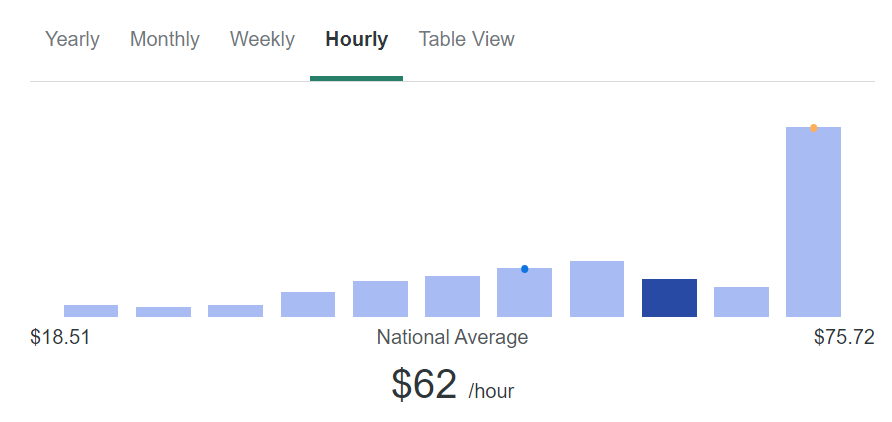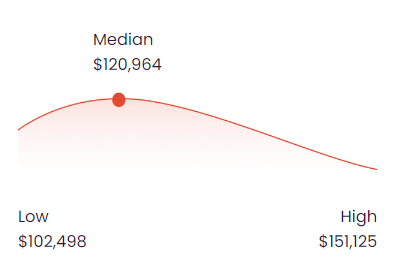ReactJS Developer Hourly Rate Guide: A Comprehensive Look at the Industry Standards
The blog provides a comprehensive guide to ReactJS developer hourly rates in the US and Latin America, with hourly rates in the United States ranging from $70 to $150 per hour, and in Latin America from $30 to $70 per hour, all of which vary based on factors such as location and tech stack.
ReactJS has become one of the most popular JavaScript libraries for building user interfaces. It’s widely used by developers and businesses alike, making it a sought-after skill set in the tech industry. With a growing demand for ReactJS developers, it’s important to understand the hourly rate that one can expect to pay before hiring React developers who are suited for your job role.
Table of Contents
In this article, we’ll take a closer look at the ReactJS developer’s hourly rate and how it varies based on factors such as location and tech stack.
1. Hourly Rate of ReactJS Developers Based on Location
The hourly rate of a ReactJS developer varies depending on the location. In general, developers in the US and Western Europe charge a higher hourly rate than those in Eastern Europe and Asia. The hourly rate of ReactJS developers in the USA according to ZipRecruiter is from $18 – $75 per hour according to the level of experience of the developer.
Below is a table that outlines the average hourly rates of ReactJS developers in different regions.
| Region | Average Hourly Rate |
|---|---|
| United States | $100 - $150 |
| Western Europe | $80 - $120 |
| Eastern Europe | $40 - $70 |
| Asia | $30 - $50 |
| South America | $30-$70 |
As seen from the table above, the hourly rates of ReactJS developers vary significantly based on the region. The average hourly rate of a ReactJS developer in the United States is around $100-$150. In Western Europe, the hourly rate ranges from $80-$120, while in Eastern Europe, the hourly rate is around $40-$70. Developers in Asia charge the lowest hourly rates, ranging from $30-$50.
Hence, according to talent.com, the hourly rate of a midlevel React.JS developer is $57.96 in 2023, which adds up to $120K per year. A senior ReactJS developer earns up to $72.42 per hour.
2. Hourly Rate of ReactJS Developers Based on Tech Stack
ReactJS developers can work with different tech stacks, which also affects their hourly rate. Below is a table that outlines the average hourly rates of ReactJS developers based on their tech stack.
| Tech Stack | Average Hourly Rate |
|---|---|
| React Native | $90 - $120 |
| Redux | $70 - $100 |
| Next.js | $80 - $110 |
| Gatsby | $90 - $130 |
| GraphQL | $80 - $110 |
| Node.js | $70 - $100 |
As seen from the table above, the hourly rates of ReactJS developers also vary based on their tech stack. Developers who work with React Native charge an average hourly rate of $90-$120. Those who work with Redux charge around $70-$100 per hour, while those who work with Next.js charge around $80-$110 per hour. Developers who work with Gatsby charge around $90-$130 per hour, while those who work with GraphQL charge around $80-$110 per hour. Finally, developers who work with Node.js charge around $70-$100 per hour.
According to the statistics of talent.com, the hourly rate of a React Redux developer is $62.50, the hourly rate of a React Native developer is $60.55, and the hourly rate of a Next.js developer is $58.85 . A Gatsby developer makes about $54.47 per hour, a GraphQL developer makes $54.69 per hour, and a Node.js developer earns an average hourly rate of $58.94 in the United States according to the statistics of talent.com.
3. Comparing ReactJS Developer Hourly Rate with Other Technologies
ReactJS is a popular JavaScript library used for building user interfaces. However, it’s essential to compare the hourly rate of ReactJS developers with other technologies to understand the industry standards better.
Angular and Vue.js are other popular JavaScript frameworks used for building user interfaces. Below is a table that outlines the hourly rates of developers who work with ReactJS, Angular, and Vue.js.
| Technology | Average Hourly Rate |
|---|---|
| ReactJS | $80 - $120 |
| Angular | $70 - $110 |
| Vue.js | $60 - $100 |
As seen from the table above, ReactJS developers charge an average hourly rate of $80-$120, which is slightly higher than Angular developers, who charge around $70-$110 per hour. Vue.js developers, on the other hand, charge an average hourly rate of $60-$100, which is lower than ReactJS and Angular developers.
4. Hourly Rate Comparison of ReactJS with Backend Technologies
Backend technologies, such as Node.js, PHP, and Ruby on Rails, are also essential when building web applications. Below is a table that outlines the hourly rates of developers who work with ReactJS and these backend technologies.
| Technology | Average Hourly Rate |
|---|---|
| ReactJS | $80 - $120 |
| Node.js | $70 - $100 |
| PHP | $40 - $70 |
| Ruby on Rails | $50 - $80 |
As seen from the table above, ReactJS developers charge an average hourly rate of $80-$120, which is higher than Node.js developers, who charge around $70-$100 per hour. PHP developers charge the lowest hourly rates among the technologies compared, with an average hourly rate of $40-$70. Ruby on Rails developers charge around $50-$80 per hour, which is lower than ReactJS developers but higher than PHP developers.
However, Payscale suggests otherwise. Thus, accordingly, the hourly rate of an Angular developer is $45 in the United States. Payscale statistics further mention that a Vue.js developer earns an average hourly rate of $33.54 in the United States as of 2023.
5. What are the Factors that affect the React developer hourly rates?
When hiring a React developer, several factors can affect their hourly rate. Understanding these factors can help you make better decisions about the budget and the type of developer to hire.
Here are some of the factors that can affect the hourly rates of React developers:
5.1 Experience and Skillset:
Experienced and highly skilled React developers typically charge higher hourly rates than those who are just starting. Developers with a deep understanding of the React library, as well as other programming languages and frameworks, can demand a premium for their services.
5.2 Location:
The hourly rate of a React developer can vary greatly depending on their location. Developers in regions with higher costs of living typically charge more than those in lower-cost regions. For instance, developers in the United States and Europe may charge more than those in Asia or South America.
5.3 Project Complexity:
Projects that require advanced programming skills, such as building custom React components or integrating React with other technologies, may require a more experienced developer. These developers may charge higher hourly rates due to the complexity of the work.
5.4 Project Scope and Timeline:
The scope and timeline of a project can also affect the hourly rate of a React developer. Projects with shorter deadlines or tight timelines may require a developer to work overtime or weekends, which can increase their hourly rate. Similarly, larger projects that require more time and effort may command higher hourly rates.
5.5 Freelancer vs. Agency:
Hiring a React developer from an agency may cost more than hiring a freelancer, as agencies often have more overhead costs. However, agencies can provide access to a team of developers with diverse skill sets, which may be beneficial for complex projects.
5.6 Demand and Supply:
The hourly rate of a React developer can also depend on the demand for their services. If there is a high demand for React developers in a particular region or industry, they may be able to command a higher hourly rate. Conversely, if there is an oversupply of React developers, the hourly rate may be lower.
6. Conclusion
The hourly rate of a ReactJS developer varies depending on several factors, including location and tech stack. In general, developers in the US and Western Europe charge a higher hourly rate than those in Eastern Europe and Asia. The hourly rates of developers also vary based on their tech stack, with developers who work with Gatsby and React Native charging the highest hourly rates.
For employers, it’s essential to have a grasp of these factors and align their expectations with industry standards when planning to hire a ReactJS developer. Utilizing resources such as the ReactJS hiring guide can provide valuable insights into this process, alongside our React JS job descriptions, and React JS interview questions. You can check out our React JS annual salaries guide here for more information.
When hiring a ReactJS developer, it’s important to consider these factors and understand the industry standards for hourly rates. Conversely, when working as a ReactJS developer, it’s essential to know your worth and charge a fair hourly rate based on your experience and skill set. Overall, understanding the hourly rate of a ReactJS developer is crucial for both employers and employees to ensure a successful partnership.
Staying informed about market trends is important, which is why we bring you the React JS annual salaries article, along with the React JS hourly rates.
Table of Contents











